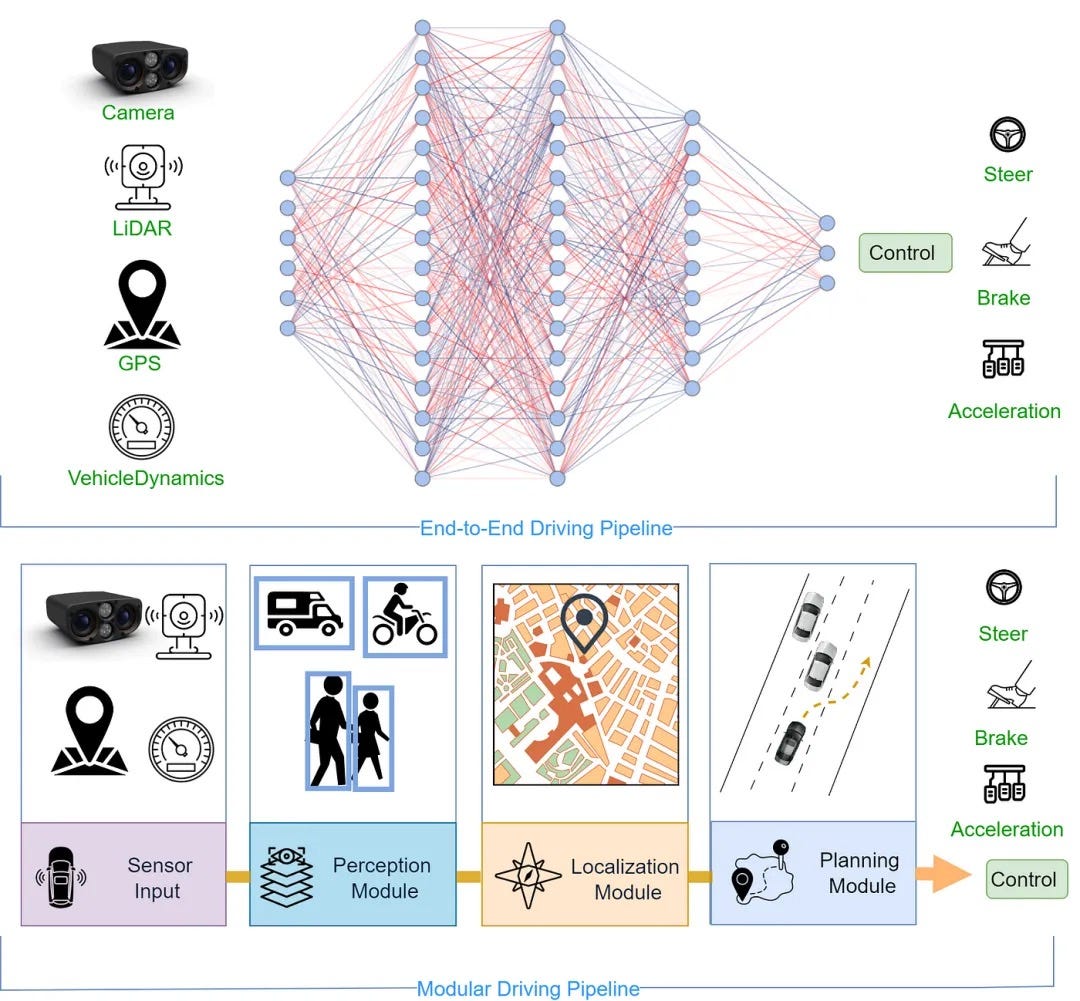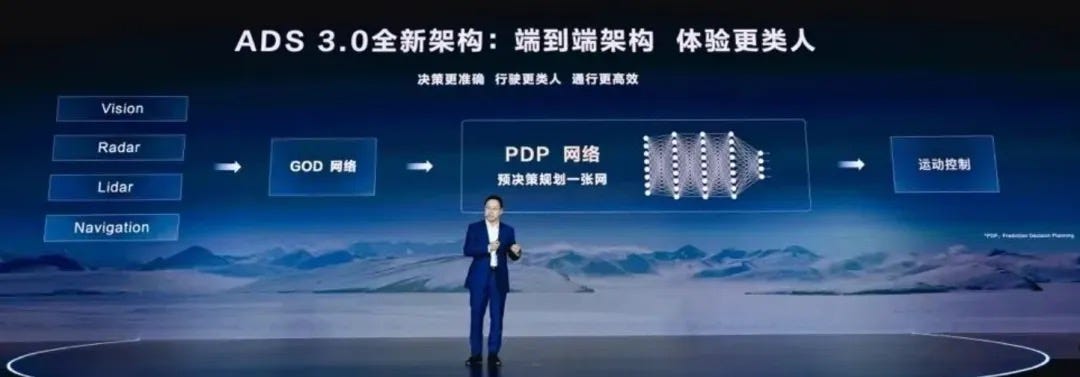China’s Autonomous Driving Superstar: Opportunities and Challenges of End-to-End Technology | reinvent the wheel #2
How End-to-End architecture is redefining the future of mobility in China
In the high-stakes race of autonomous driving, one term has become the darling of tech enthusiasts and industry insiders alike: end-to-end technology. A sleek buzzword with revolutionary potential, it’s as if modular systems are the flip phones of yesterday, and end-to-end is the smartphone everyone’s queuing up for. Yet, for all its allure, the road to true end-to-end autonomy is riddled with potholes, especially in China. As Tesla dazzles with its Full Self-Driving (FSD) V12 and prepares to roll it out in the Chinese market, local EV brands are grappling with their own hurdles—data shortages, safety concerns, and the race to scale.
1. End-to-End: The Buzzword in China’s Autonomous Driving Scene
End-to-end (E2E) autonomous driving technology has recently become a hot topic in China’s autonomous driving industry, captivating the attention of experts and enthusiasts alike. This surge in popularity stems largely from Tesla’s 2024 release of its Full Self-Driving (FSD) V12, a version built entirely on an end-to-end architecture. Its outstanding performance and user experience have made it a standout in the autonomous driving sector. As Tesla prepares to introduce FSD V12 to the Chinese market in early 2025, the spotlight on end-to-end technology has grown even brighter.
But why has end-to-end technology sparked such interest? To understand its significance, it’s essential to compare it with traditional modular architectures. Modular systems break down autonomous driving tasks into discrete components—perception, prediction, planning, and execution—each functioning independently to complete the overall driving process. While modular designs offer clarity and division of labor, they have revealed limitations as the field matures.
The advantages of an end-to-end approach are profound. First, end-to-end systems enable seamless information flow by unifying all tasks under one framework, avoiding the information loss that can occur in modular designs. Second, they exhibit superior learning and generalization capabilities, as these systems rely on data-driven approaches to adapt to diverse scenarios, unlike modular systems that depend on manually programmed rules. Lastly, development and iteration cycles are significantly faster with end-to-end systems. For instance, Tesla’s FSD V12 reduced its codebase from 300,000 lines to just 2,000, demonstrating the efficiency of this approach in scaling and updating.
2. Tesla: The Trailblazer of End-to-End Autonomous Driving
Tesla’s pioneering role in end-to-end autonomous driving has set a benchmark for the industry, shaping the technological trajectory of the field. The evolution of Tesla’s FSD system illustrates continuous breakthroughs, particularly in perception and decision-making.
In 2021, Tesla introduced its HydraNet algorithm, a multi-task learning framework capable of handling multiple autonomous driving tasks simultaneously. This architecture enhanced efficiency and minimized information loss. Later that year, Tesla incorporated bird’s-eye-view (BEV) technology combined with Transformer models, enabling the integration of 2D camera data into a 3D representation. This innovation resolved occlusion issues and allowed for parallel processing of perception and prediction. By 2022, Tesla launched its Occupancy Network, which brought true 3D perception into the mix. This advancement allowed the system to recognize unseen objects, understand their shapes, and predict their trajectories.
These milestones culminated in Tesla’s release of FSD V12 in 2024, a fully end-to-end system that outperformed the prior version (V11) in just a few months. Tesla’s journey underscores the transformative potential of end-to-end technology, redefining the landscape of autonomous driving.
3. Chinese EV Brands: Facing Data, Computing, and Safety Hurdles
Despite the promising future of end-to-end technology, Chinese EV brands face significant challenges in their efforts to catch up with Tesla’s progress. Three primary obstacles stand out: data, computing power, and safety.
Data collection remains a major hurdle. Tesla’s fleet of millions of FSD-equipped vehicles operates in shadow mode, gathering vast amounts of real-world driving data. In contrast, Chinese EV brands have relatively smaller fleets and uneven data quality, limiting their ability to train robust end-to-end models. Moreover, Tesla’s in-house Dojo supercomputer provides unparalleled computing power for training and deploying end-to-end systems. Chinese brands, on the other hand, largely rely on third-party chips like NVIDIA’s, which come with constraints in scalability and cost-effectiveness.
Tesla builds data centers to accommodte the H100s.
Safety and interpretability present additional challenges. The black-box nature of end-to-end models makes debugging and validation difficult, raising concerns about their reliability in critical scenarios. Unlike modular architectures, which allow engineers to isolate and address specific issues, end-to-end systems are less transparent, complicating efforts to ensure compliance with traffic laws and prevent collisions.
Nevertheless, several Chinese EV brands are exploring end-to-end solutions, often through hybrid approaches that combine neural networks with traditional modular components. For example, Huawei’s ADS 3.0 integrates neural networks in specific modules while maintaining conventional systems for better control. Similarly, XPeng Motors has expressed keen interest in end-to-end architectures, with its CEO praising Tesla’s FSD V12 and signaling XPeng’s commitment to learning from its advancements.
Huawei ADS 3.0: Two Stage End-to-End Approach
4. The Future Is Large Models, Safety, and Efficiency
The future of end-to-end autonomous driving technology points toward greater intelligence, enhanced safety, and improved efficiency. As the industry evolves, three key trends are emerging.
Large models are expected to play a pivotal role in autonomous driving. The success of large language models (LLMs) like ChatGPT demonstrates the potential of AI to process complex information and generate nuanced responses. Applying similar principles to autonomous driving could enable vehicles to better understand intricate driving scenarios and make smarter decisions.
Safety remains a critical challenge for end-to-end models. Improving the interpretability of these systems will be essential for ensuring public trust and regulatory compliance. Innovations like Huawei’s instinctive safety network, which incorporates redundancy mechanisms, could provide a path forward by enhancing reliability and minimizing risks in edge cases.
Efficiency is another area of focus. End-to-end systems demand substantial computational resources, leading to high costs and energy consumption. Future advancements in model compression and acceleration could lower the barriers to deployment, making end-to-end technology more accessible and cost-effective for a wider range of applications.
5. Grabbing the Opportunity Amid Challenges
End-to-end autonomous driving technology represents a significant shift in how vehicles are designed to navigate complex environments. While the challenges of data, computing, and safety are formidable, they also present opportunities for innovation and collaboration. By leveraging advancements in AI, fostering partnerships, and investing in research, Chinese EV brands have the potential to carve out a competitive edge in this rapidly evolving field.
Tesla’s dominance serves as both an inspiration and a benchmark, but the journey of end-to-end technology is far from over. As the landscape of autonomous driving continues to transform, those who embrace the challenges and seize the opportunities will shape the future of mobility.






